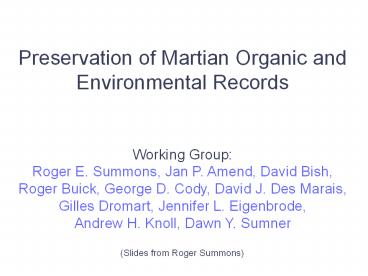How it was different on Mars ? Biomas abundance - PowerPoint PPT Presentation
1 / 12
Title:
How it was different on Mars ? Biomas abundance
Description:
Preservation of Martian Organic and Environmental Records Working Group: Roger E. Summons, Jan P. Amend, David Bish, Roger Buick, George D. Cody, David J. Des Marais, – PowerPoint PPT presentation
Number of Views:62
Avg rating:3.0/5.0
Title: How it was different on Mars ? Biomas abundance
1
Preservation of Martian Organic and Environmental
Records Working Group Roger E. Summons, Jan
P. Amend, David Bish, Roger Buick, George D.
Cody, David J. Des Marais, Gilles Dromart,
Jennifer L. Eigenbrode, Andrew H. Knoll, Dawn Y.
Sumner
(Slides from Roger Summons)
2
Charge to the Working Group
Develop specific criteria to identify the most
likely environments and conditions for
biosignature preservation that will inform MSL
landing site selection and landed operations
- A ranked order of biosignatures detectable with
MSL payload - A ranked order of biosignature taphonomic
windows - include a confidence evaluation for geological
context - Provide some sense of priority of
(paleo)environments from the perspective of
habitability preservation - An evaluation of the likelihood for survival of
meteoritic organics
3
What can we say about biosignatures on Early Mars?
Biosignature formation processes and preservation
windows Mars and Earth should be comparable
Some biosignatures have qualities that could
be termed generic Mars and Earth should be
comparable
4
Types of Biosignature and a Ranking
Biosignatures detectable by MSL How definitive as a biosignature? How well it can be measured by MSL?
biogenic organic molecules highly definitive readily with SAM
biogenic gases highly definitive readily with SAM
body fossils often definitive with MAHLI if large enough
biofabrics sometimes definitive with MAHLI, MastCam
stable isotopic compositions occasionally definitive context critical readily with SAM
biomineralization/ alteration occasionally definitive detectible with CheMin, ChemCam
spatial chemical patterns rarely definitive detectible with CheMin, ChemCam
5
Organic Matter and Organic Compounds
Molecular biosignatures at a glance Enantiomeric excess Homochirality characterizes terrestrial biochemicals Structural isomer preference Observing a limited subset of the possible stable isomers in a complex molecule Repeating constitutional sub-units or atomic ratios Signifies complex molecules constructed from small common building blocks Systematic isotopic ordering at molecular and intramolecular levels As above Uneven distribution patterns or clusters (e.g., C-number, concentration, d13C) of structurally related compounds.
Biological origins ? Patterns Orderly
Systematic Non-biological origins ? Disorder
Thermodynamics rule!
6
Biogenic Gases
Mars atmosphere CO2 95.3 N2, 2.7
Ar 1.6 CO 0.07 O2 0.13 H2O 0-300 ppm CH4 ppb
? seasonally and spatially variable (Mumma et
al., Science 323, 1041 2009)
N2O, H2S, DMS, ethylene ??
7
Preservation Windows (Taphonomy)
Taphonomic window for preservation Confidence in context if detected How this informs about potential biosignature preservation
atmospheric gases exceptional predictable via chemical modeling
crystalline sedimentary mineral entrainment of organic compounds very high can deduce formation mechanism and subsequent history
biofabric lithification very high can deduce history from lithology stratigraphic relationships
body fossil preservation very high can deduce history from lithology and stratigraphic relationships
mineral replacement of body fossil high can deduce from mineralogy
8
Taphonomy The Role of Sediment Lithology OM
preservation by physical protection (Hedges,
Keil, Mayer 1990s)
Data for coastal sediments C clay L silt S
sand B bulk
Organic matter concentrations strongly correlate
with mineral surface area (or small clay
particles). As degradation proceeds an
increasingly large fraction of the remaining
organic matter is protected by its association
with mineral surfaces . Hedges and Keil,
1995
9
Biosignature Formation Processes strategies used
by life on Earth
Photosynthesis to gain carbon energy Consuming
the products of photosynthesis Chemosynthesis
using chemical energy water-rock
interactions biologically-produced
compounds combination of both
10
Biosignature Formation Preservation
Table 3
ID by remote sensing ID by remote sensing ID by remote sensing
Martian context --gt Early Mars Environment Support Biotic C formation Support for Abiotic C formation Support Carbon Conc Support Preservation Potential for Recent Exhumation geomorphic mineralogic stratigraphic ID by MSL
Hydrothermal (lt100C) subsurface mod mod (F/T) low mod low mod mod-high n/a high
Hydrothermal (lt100C) surface high low mod-high mod mod high mod-high low high
Aeolian sediments (sand) low low low low low high n/a mod high
altered aeolinites (dust) very low low low low low low n/a n/a high
Fluvial channel low low low low high high n/a high high
Fluvial floodplain low-mod low mod mod possible high n/a high high
alluvial fan low low low low low high n/a high high
Deltaic high low high high low high n/a high high
Lacustrine (perennial) high low high high high mod mod mod high
Lacustrine (evaporitic)(Cl) med low high high-very high high mod high mod high
Lacustrine (evaporitic)(SO4) low low high high-very high high mod high mod high
Regional Groundwater pore system low low low low high n/a n/a n/a mod
Glacial deposits low low low low high high n/a low high
permafrost low low low mod mod high n/a n/a high
soil (surface fines chemically altered by atmosphere ) low low low low low n/a n/a (albedo and TI) n/a high
Pyroclastic Deposits (unaltered) low low low low low mod low high high
Volcanic flows very low low low low low high high mod high
Regolith/Fractured Bedrock (not soil) low low low low low high n/a n/a high
11
Synthesis
- MSL has the potential to detect biosignatures
should they exist on Mars - OM, diagnostic organic molecules biogenic
gases are the most definitive ( detectable with
SAM). Sequestration from oxidation essential for
preservation. - Clay minerals promote the preservation of
diagnostic organic molecules on Earth.
Examination of accumulations of sedimentary clay
minerals on Mars would be a good strategy for
life detection. - Carbonate, silica and other crystalline
minerals also sequester and preserve organic
biosignatures
12
Synthesis
- Stable isotopic signatures are commonly
considered diagnostic for biology. However,
without detailed context, stable isotopic
signatures rarely provide strong evidence for
biological activity. - Early Earth is the best analogue we have for
guiding the search for biosignatures on Mars.































